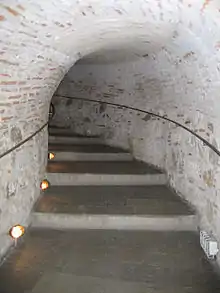Equestrian staircase
An equestrian staircase or riders' staircase is a very gently sloping flight of steps that can be negotiated by horses. Its origins may be seen in the mule staircases in steep terrain in open country.

Use in interior rooms
Its design principles found their way from road construction into building architecture. Here an equestrian staircase was a spiral, curved or repeatedly interrupted ramp within buildings, that had a gently sloped and a non-slip floor, either smooth or frequently divided by transverse ridges. This type of ramp occurs in the towers of churches, castles, fortifications and palaces as well as in the architecture of other buildings within fortifications villas and palaces.[1]
Representation
From the 15th century, imposing equestrian staircases were built in the stately homes of the nobility. These staircases enabled riders to reach the upper floor on horseback. The equestrian staircase leading to Vladislav Hall in Prague Castle, which was built around 1500, is one of the oldest known examples.
Other equestrian staircases are found:
- in the Château d'Amboise, the Tour de Minimes and the Tour Heurtault both have equestrian staircases
- in the Old Palace in Bayreuth
- in the Berliner Stadtschloss (demolished 1950)
- in the Ehrenburg in Brodenbach on the Moselle
- in the Stallhof in Dresden
- in Schloss Riedegg in Gallneukirchen
- in the Landshut town residenz
- in citadel in Spandau
- in the Old Palace in Stuttgart
Stepless equestrian ramps
Occasionally ramps were built without any actual steps, enabling horses to draw a carriage or wagon up the incline. There are examples in Venice (St Mark's Campanile), Geneva (city hall) and Copenhagen (Round Tower).
Gallery
 Mule staircase in the White Tower of Thessaloniki
Mule staircase in the White Tower of Thessaloniki Equestrian staircase outside Schloss Klippenstein, Radeberg
Equestrian staircase outside Schloss Klippenstein, Radeberg.jpg.webp) Stepless ramp in the Round Tower in Copenhagen (1642)
Stepless ramp in the Round Tower in Copenhagen (1642) Equestrian staircase as an element of the Großsedlitz Baroque Garden
Equestrian staircase as an element of the Großsedlitz Baroque Garden Equestrian staircase in Old Castle (Stuttgart)
Equestrian staircase in Old Castle (Stuttgart)
See also
References
- Roswitha Beyer: Eselstreppe, in: Reallexikon zur Deutschen Kunstgeschichte, Vol. 6, 1968, Cols. 21–22